Sheffield Corporation Tramways
Summary
Following the take-over of the Sheffield Tramways Company, the corporation issued all horsecar staff with single-breasted uniform jackets with six buttons and stand-up collars; the latter certainly bore insignia of some kind, more than likely an employee number. Caps were in a kepi style with a stiff horizontal peak style; they bore a cap badge of individual system initials — 'S C T' — very probably in brass.
Staff working the new electric services wore the same jackets, the collars of which carried an employee number (on both sides) in individual brass numerals, but prefixed with a grade letter — either 'M' or 'C' — for 'motorman' and 'conductor', respectively. The caps were by this time of the drooping-peak variety; they bore a large cap badge comprising the municipal arms within a wreath, all above a ribbon containing 'CORPN TRAMWAYS'. These exist in both brass and nickel (see below), with the latter possibly being the preserve of inspectors, though this is pure speculation. At some point in the early-Edwardian era, a gradual change was made to double-breasted jackets with four pairs of buttons and lapels. Caps appear to have been changed in the mid-to-late Edwardian era to a more modern peaked type with a tensioned crown (top), the large cap badge being superseded by a simpler unmarked municipal-device badge (see below). Although subtle alterations were made to the style of the jacket over the course of the ensuing decades, it essentially remained the same right through to closure, though a switch was very probably made to 'Sheffield Corporation Transport' insignia following the re-naming of the undertaking in 1936. The 'Transport' insignia were almost certainly nickel initially, but were eventually switched to chrome.
Tramcar staff were also issued with double-breasted greatcoats with five pairs of buttons and high fold-over collars; these carried the same insignia as the jackets worn underneath. Once again, apart from the switch to chrome insignia, the overcoats appear to have remained the same — stylistically — right through to 1960, save for the addition of epaulettes in later years.
Several examples of 'Sheffield Corporation Tramways' brass and blue enamel shield-shaped badges have survived, which on the face of it would appear to be employee number badges; however, there is no photographic evidence whatsoever to indicate why, when or indeed how these were worn.
Sheffield Corporation Tramways & Motors, as well as Sheffield Corporation Transport Department issued 'merit' badges to their staff. These took the form of a five-pointed star, the centre of which (also star shaped) contained the word 'MERIT', inlaid with enamel; the star was surrounded by the full department title within a circle. Different coloured enamels were used — white, blue and yellow are known — which presumably represented 5, 10, 15 years good service etc., though which colour represented which length of service is unknown. The material used for this badge changed from brass to chrome, probably in the 1940s.
In the early days of electric services, inspectors were issued with double-breasted jackets with four pairs of buttons (possibly five including those hidden by the collars), which somewhat surprisingly, were unmarked (see photo below). The jackets had two waist pockets (with flap closures) a slit breast pocket and lapels; the upper part of the latter (the collars) bore the grade — 'Inspector' — along with an employee number, both embroidered. The jacket sleeves bore a chevron of a finer material than the main jacket, probably a decorative embellishment reflecting the wearer's senior grade. Caps were of the drooping-peak type; they carried the same 'CORPN TRAMWAYS' cap badge as those worn by tramcar staff, but possibly nickel rather than brass.
At some point, probably in the early-Edwardian era, a switch was made to a more traditional style of tramway inspector's uniform, comprising a single-breasted jacket with slit breast pockets, hidden buttons (or more likely an hook and eye affair) and stand-up collars; the latter probably bore 'Inspector' in embroidered script lettering. The jackets (including the slit breast pockets) were edged in a finer material than the main body, and the sleeves were possibly embellished with a chevron of the same material. These jackets were eventually superseded by a more modern uniform with lapels, though photographic evidence remains elusive. It seems likely that the caps were changed from the drooping-peak type to peaked type with a tensioned crown (top) in the Edwardian era (at the same time as they were introduced for tramcar staff), along with the cap badge, which was switched to the simpler municipal-device design. Inspectors appear to have been issued with the same style of greatcoat as the tramcar staff, though presumably with different collar insignia.
In common with the majority of UK tramways systems, Sheffield employed significant numbers of female staff during the Great War (almost 50%) to replace men lost to the armed services. These ladies were issued with long, blue, single-breasted tailored jackets with four buttons, two waist and two breast pockets (with button closures), lapels and a waist belt (with button fastening). The collars carried an employee number in small metal numerals (almost certainly brass), which unlike their male counterparts, did not bear a grade prefix. Hats took the form of straw bonnets (for summer use) with a cockaded hat band, upon which the standard municipal-device badge was carried (see below). For winter wear, the ladies were provided with dark-coloured waterproof bonnets with a narrow brim; these probably bore the same cap badge as the straw bonnets. The Sheffield ladies were also issued with long, single-breasted topcoats with five buttons and high, fold-over collars; the latter bore the employee's number in small individual numerals (again probably brass).
Female staff were also employed during the Second World War (almost 50% of the total staff), and indeed continued to be employed after the war and right up until closure. A photograph which is believed to date from the Second World War shows a tram conductress wearing a single-breasted jacket with two breast pockets (with faux button closures), lapels and piped epaulettes (again with button closures), along with a matching pleated skirt; the jacket does not appear to have borne any insignia. Headwear took the form of a military-style field cap with a long fabric peak; the cap carried the standard municipal-device badge. At some point, conductresses were also provided with trousers as an alternative to a skirt. In the late 1940s/1950s the jacket epaulettes carried a badge of some description, though whether this was an employee number or a municipal-device badge is unclear. The field caps were eventually superseded by baggy motor caps with a glossy peak; these probably bore the small municipal-device badge, though this remains to be proven photographically.
Although decent quality photographs are scarce, it appears that they were issued with tailored single-breasted jackets and trousers, along with baggy caps with a glossy peak. It is likely that these bore the same insignia as their male colleagues.
For a history of Sheffield's tramways, see: 'Sheffield Corporation Tramways: an illustrated history' by K Gandy; Sheffield City Libraries (1985).
Images
Horse tram drivers and conductors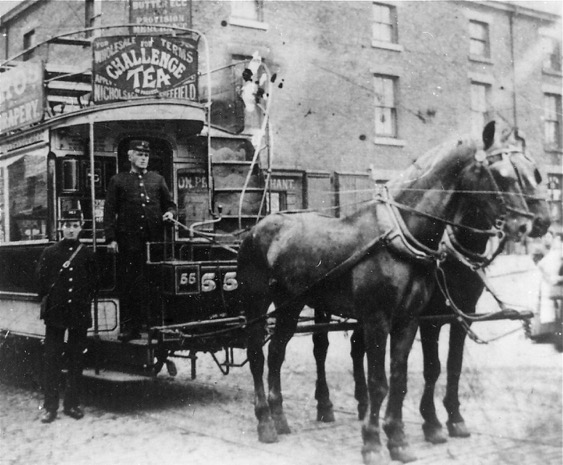
The crew of Horsecar No 55 pose for the cameraman outside the Red Lion Hotel at the Heeley terminus — photo undated, but possibly taken not long after this car's introduction in 1897. Both men are wearing single-breasted tunics and kepi-style caps, which probably bear individual system initials, 'S C T'. Photo courtesy of the Tramways and Light Railway Society, with thanks to David Voice.
Motormen and conductors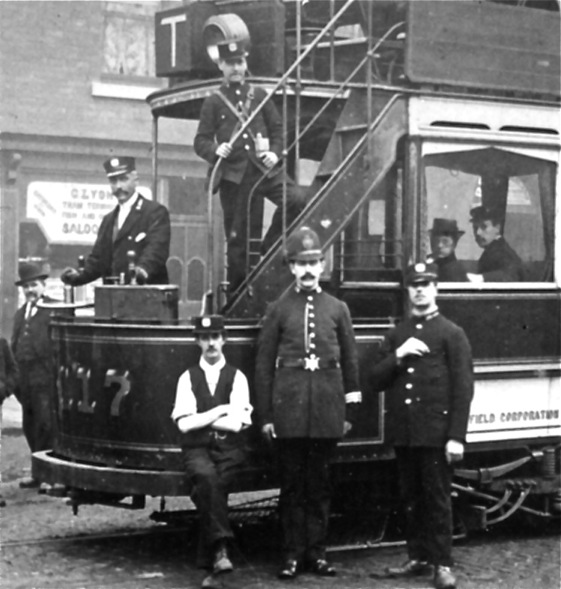
An array of tramcar staff pose with a fairly new looking Tramcar 217 working the Tinsley route — photo undated, but probably taken around 1900 (the destination boxes were only in use from then until 1905). The conductor has a single-breasted tunic, as does the individual next to the policeman, who may possibly be an inspector; the motorman, however, is wearing a double-breasted jacket. Both men appear to be wearing drooping-peak caps rather than kepis. Photo courtesy of the Tramways and Light Railway Society, with thanks to David Voice.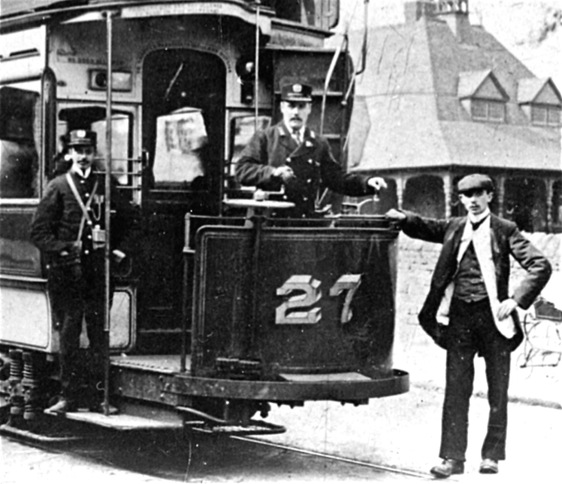
A conductor (in single-breasted tunic) and a motorman (in double-breasted jacket) with Tramcar No 27 on the Eccleshall route — photo undated, but probably taken around 1900. Photo courtesy of the Tramways and Light Railway Society, with thanks to David Voice.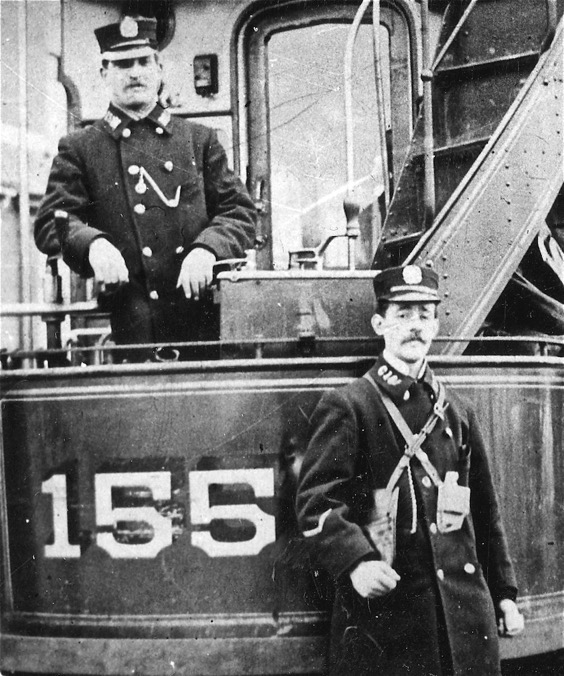
Motorman and conductor with Tramcar No 155 — photo probably taken in 1901. Both men are wearing drooping-peak caps with the large municipal tramways cap badge that was introduced around 1899. The conductor's collar badges can be clearly seen, an employee number pre-fixed with a 'C'. Note the chevron on the conductor's sleeve; this probably denotes long service or good conduct. Author's Collection.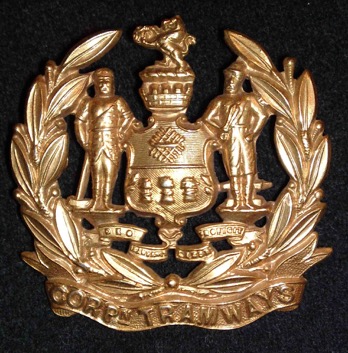
Sheffield Corporation Tramways cap badge — brass (c1899 to c1906). 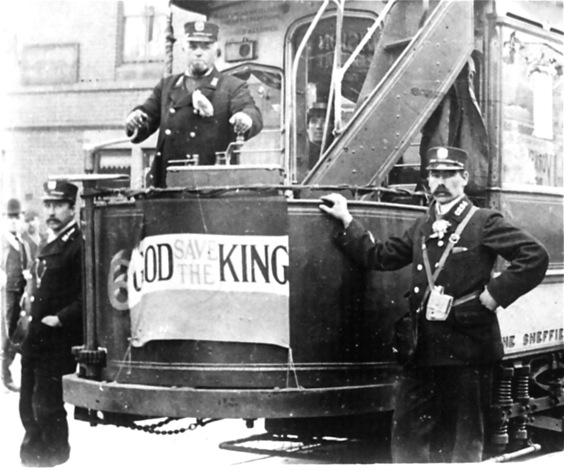
Two conductors and a motorman with an unidentified 60 series tramcar — photo undated, but possibly taken on the occasion of Edward VII's coronation in August 1902. Conductors' single-breasted tunics had by this time given way to double-breasted jackets. Photo courtesy of the Tramways and Light Railway Society, with thanks to David Voice.
A studio portrait of an SCT motorman wearing what is either a greatcoat or a lancer-style tunic — photo undated, but probably early Edwardian. The collars bear metal numerals ('368') and a letter 'M', denoting the bearer's grade. Photo courtesy of the Stephen Howarth Collection.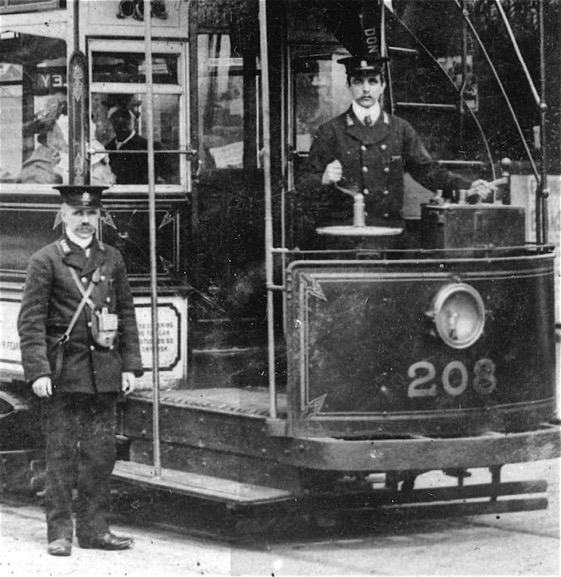
A conductor and motorman with Tramcar 208 on a Tinsley service, probably at the terminus at Millhouses — photo undated, but as the car is in 'rebuilt' condition (this took place in 1906-07) and a little tatty, it was probably taken in the late-Edwardian era or shortly before the Great War. Both men have tensioned-crown peaked caps, which bear a much smaller cap badge than worn previously. Author's Collection.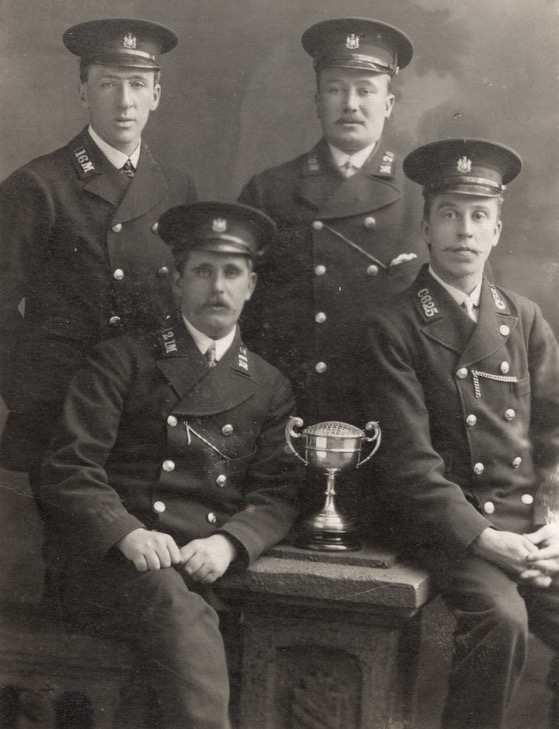
A charming studio portrait of four SCT tramwaymen, three motormen and a conductor (front right) — photo undated, but probably late Edwardian judging by the moustaches. The significance of the cup is unclear, but was possibly for a team game of four individuals. The collar insignia consist of a grade letter — 'M' or 'C' — and an employee number. Although the conductor has the 'C' preceding the number on both collars, the motormen only have this arrangement on their left-hand collars, the right having the 'M' after the number. Whether this reflected a difference between the grades or personal preference, is unclear. Author's Collection.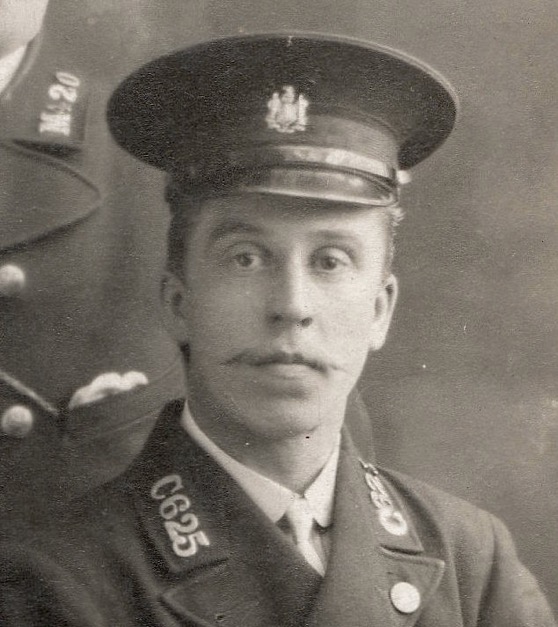
An enlargement of the above photograph showing the conductor's collar and cap insignia.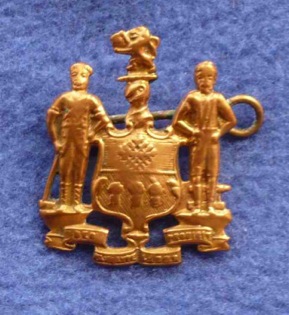
Probable Sheffield Corporation Tramways cap badge — brass — worn from around 1906 through to the 1930s or 1940s, when chrome would have taken over. Author's Collection. 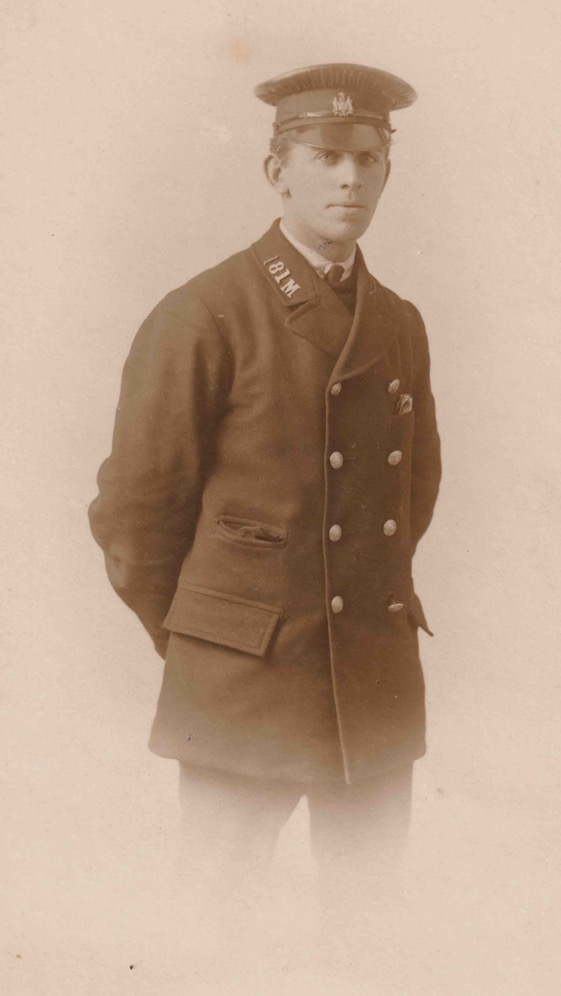
A studio portrait of SCT Motorman No 181 — photo undated, but possibly taken shortly before the Great War. Author's Collection.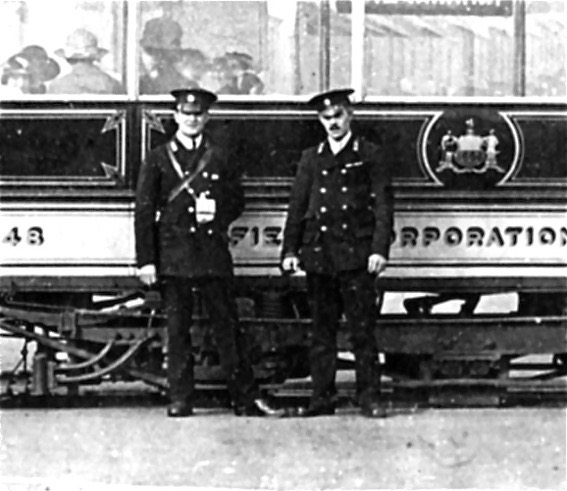
A conductor and a motorman with a rebuilt and vestibuled Tramcar No 48; photo undated, but probably taken in the early 1920s. Photo courtesy of the Tramways and Light Railway Society, with thanks to David Voice.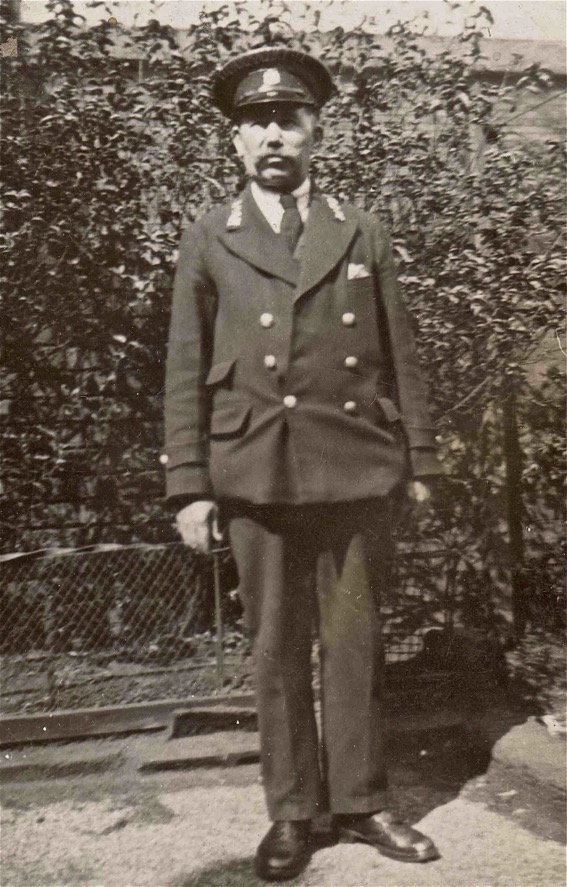
Motorman David Ward Brackenbrough — photo thought to be from the mid 1940s. With thanks to his grandson, Steve.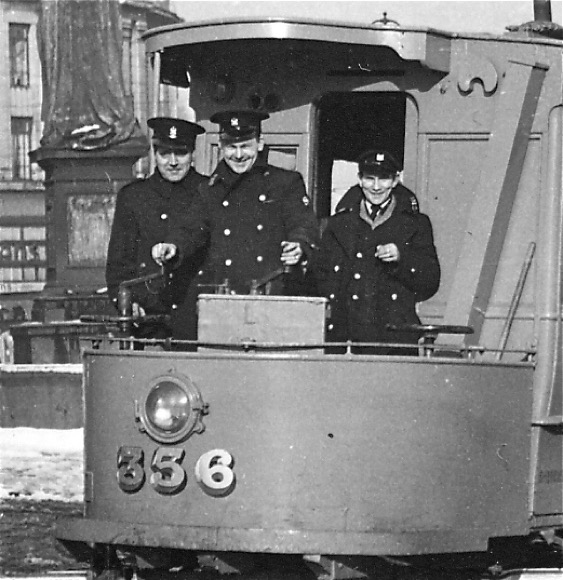
Three evidently contented tramway employees aboard Works Car No 356 in Fitzalan Square on a slushy day in the 1940s or 1950s. Photo courtesy of the Tramways and Light Railway Society, with thanks to David Voice.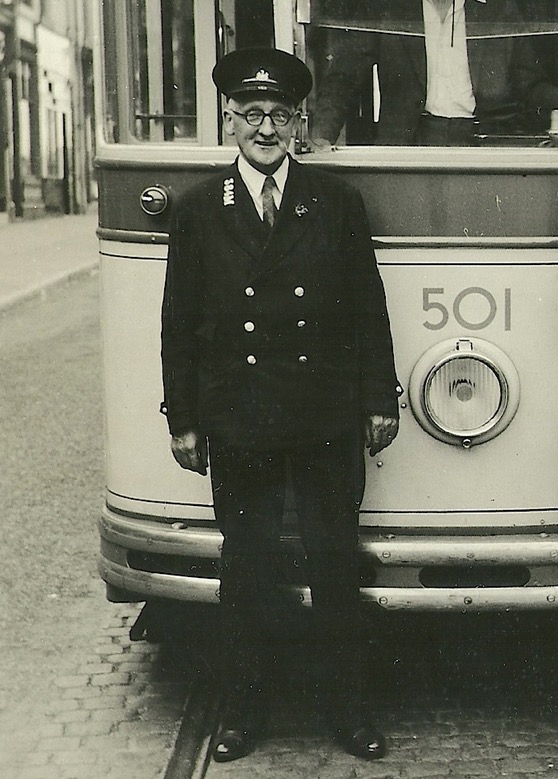
Motorman M384 with Tramcar No 501 (built 1946) on a Northern Counties Touring Society tour — photo undated, but probably taken in the 1950s or early 60s. Photo courtesy of the Stephen Howarth Collection.
Sheffield Corporation Tramways cap badge — chrome — probably worn from the 1930s or 1940s onwards. Author's Collection.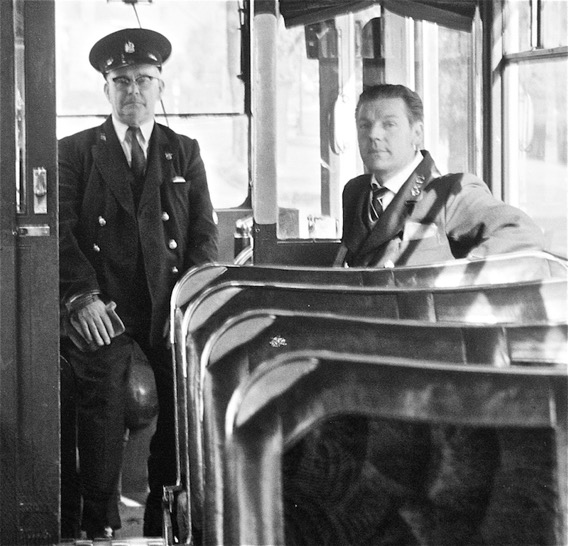
The crew of Tramcar No 501 pose for the camera of M J O'Connor at the terminus at Millhouses on the 4th October 1960. Photo courtesy of the National Tramway Museum.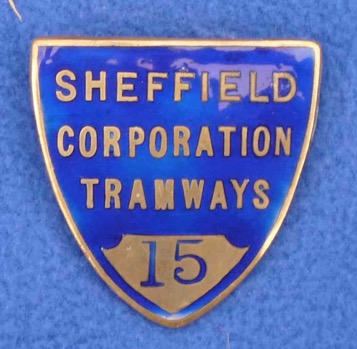
Employee number badge or licence — brass. Numerous examples of these badges have survived, though none can be seen in photographs, so it is unclear what their purpose was or whether they were even worn.
Sheffield Corporation Tramways and Motors merit badge — brass with a blue centre. Sheffield Corporation Tramways and Motors was the name used for the corporation department responsible for the trams (and buses) from 1916 through to 1934, at which point it was changed to Sheffield Transport. Author's Collection.
Sheffield Corporation Tramways and Motors merit badge worn by Motorman William Rhodes — brass with a white centre. Photo courtesy of William's grandson, Peter Rhodes.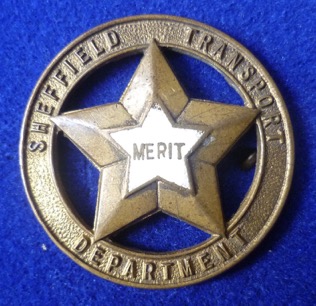
Sheffield Transport Department merit badge — brass with a white centre. These badges would probably have been issued from 1934, though the material would have been changed to chrome at some point, possibly in the 1940s. Author's Collection.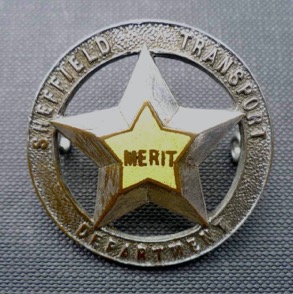
Sheffield Transport Department merit badge — chrome with a yellow centre. These badges would probably have been issued in this material from around the 1940s through to the closure of the tramway in 1960. Author's Collection.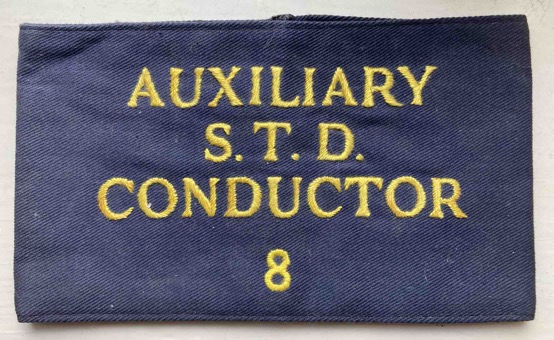
A Sheffield Transport Department Second World War auxiliary conductor's armband, No 8 — embroidered yellow lettering on navy serge. These were worn by members of the public who volunteered to help regular conductors with their non-revenue duties on darkened and/or overcrowded inner-city trams, usually in exchange for free or reduced travel. Author's Collection.
Senior staff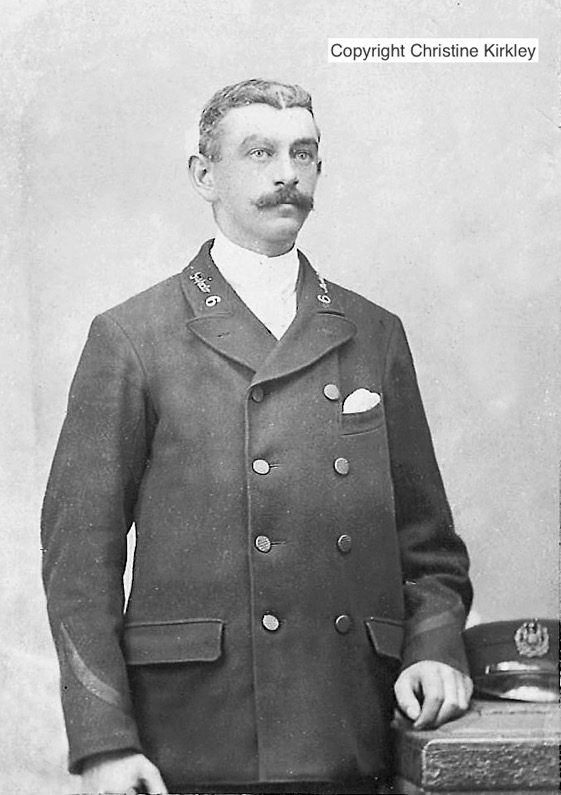
An evocative studio portrait of Motor Inspector William Higgs of Eccleshall (born in Iron Acton, Gloucestershire in 1871) — photo undated, but probably taken around the turn of the century. His lapels bear his grade — 'Inspector' — as well as his employee number ('6'); surprisingly, the uniform buttons do not bear the municipal device, but are plain with a parallel pattern of lines. His cap badge (by his left hand) appears to be the standard 'Tramways' pattern, but may have been nickel rather than brass, though this is mere speculation.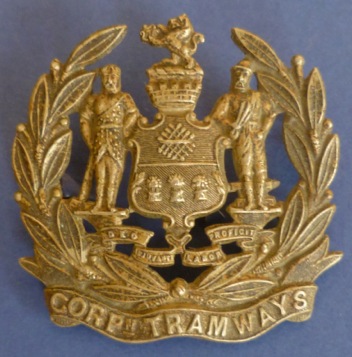
Sheffield Corporation Tramways cap badge (c1899 to c1906) — nickel (tarnished), possibly worn by inspectors.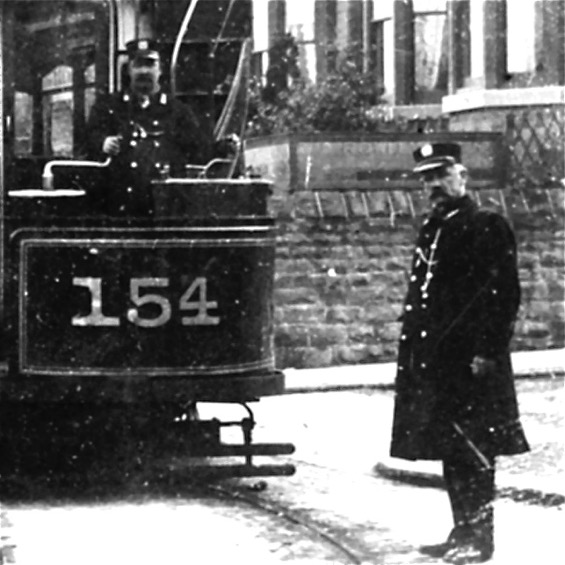
Tramcar No 154 on Route H (Hillsborough) some time between 1901 and 1905. The man on the right is probably an inspector. Photo courtesy of the Tramways and Light Railway Society, with thanks to David Voice.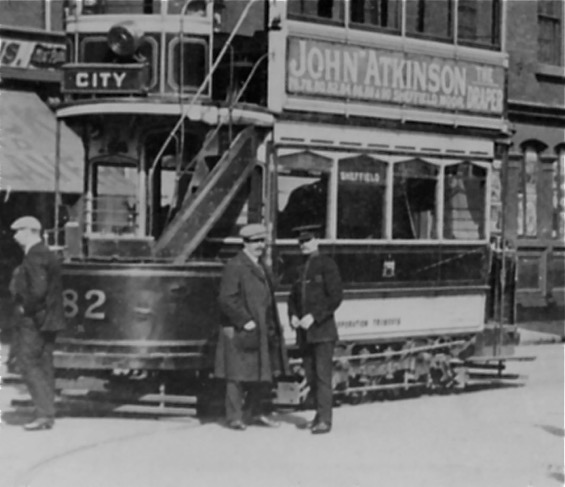
A poor-quality photograph, but one which shows an inspector in a later design of jacket, and with a tensioned-crown peaked cap. Photo courtesy of the Tramways and Light Railway Society, with thanks to David Voice.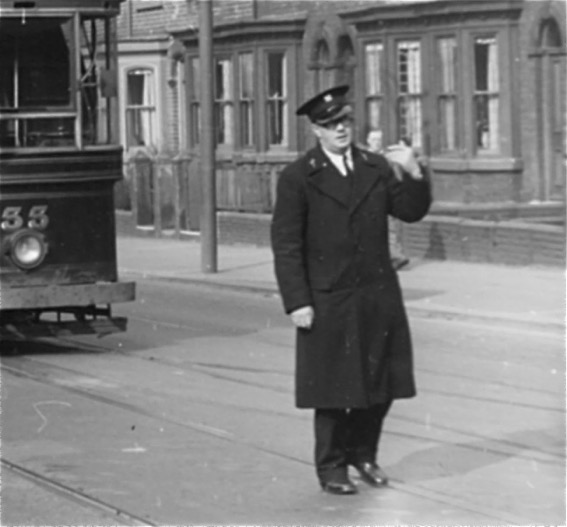
Tramcar No 55 and an inspector (probably) — photo undated, but probably taken in the 1950s. Photo courtesy of the Tramways and Light Railway Society, with thanks to David Voice.
Female staff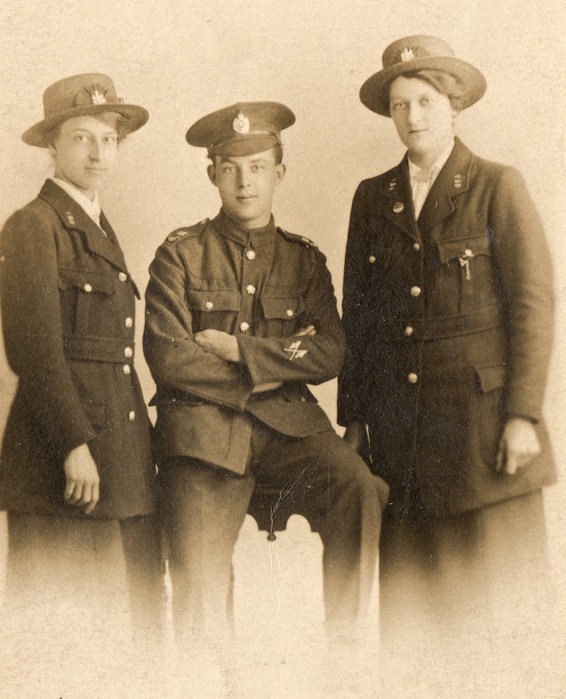
A studio portrait of two Sheffield conductresses and a Great War soldier. The lady on the left is a Miss Dalby, (No 789), the lady on the right is Nell Longhorne (No 655). Author's Collection. 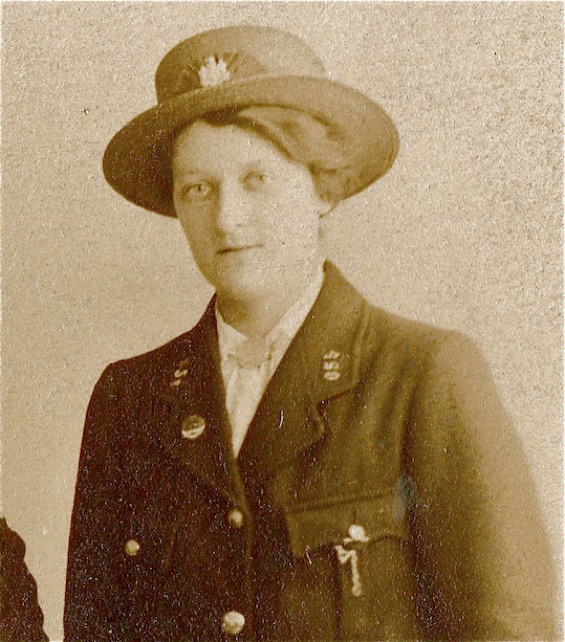
An enlargement of the above photograph showing Nell Longhorne (No 655). The standard Sheffield municipal-device cap badge is borne on a pleated cockade.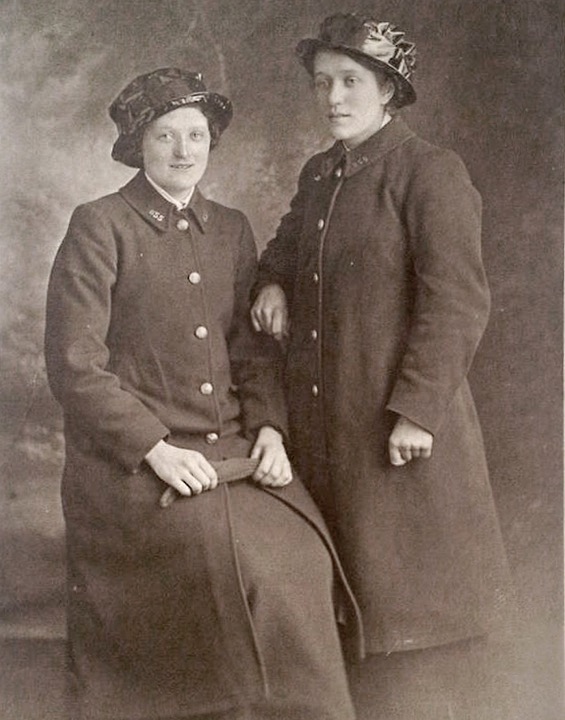
Another studio portrait of Nell Longhorne (left), along with her cousin, who was also called Nell. Both ladies are wearing greatcoats with waterproof bonnets, devoid of badges. Source unknown.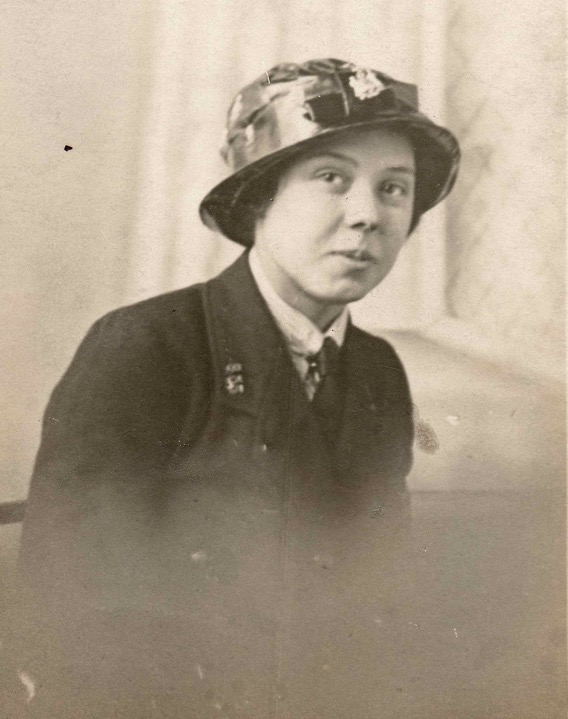
A studio portrait of a Great War Sheffield Corporation Tramways conductress, possibly Employee No 855. Author's Collection.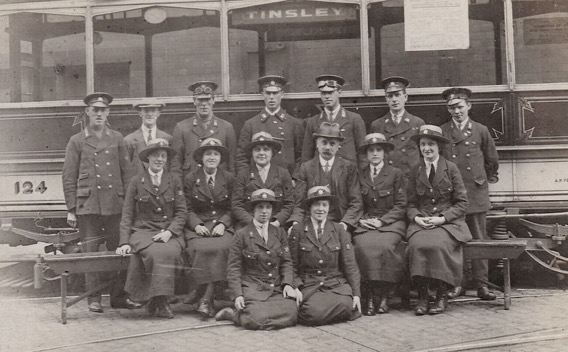
A depot shot including seven conductresses — photo undated, but certainly taken during or shortly after the Great War. Source unknown.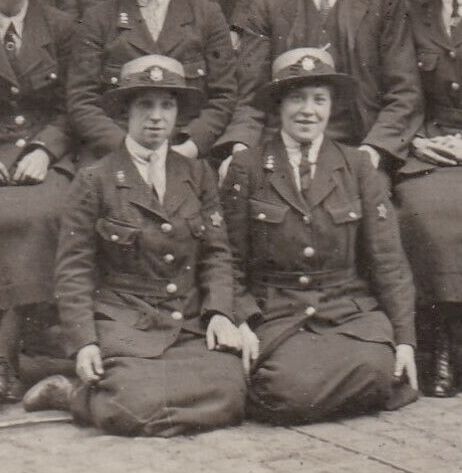
An enlargement of the above photograph showing the two conductresses seated at the front. Both have a star on their left jacket sleeve, the significance of which is unclear.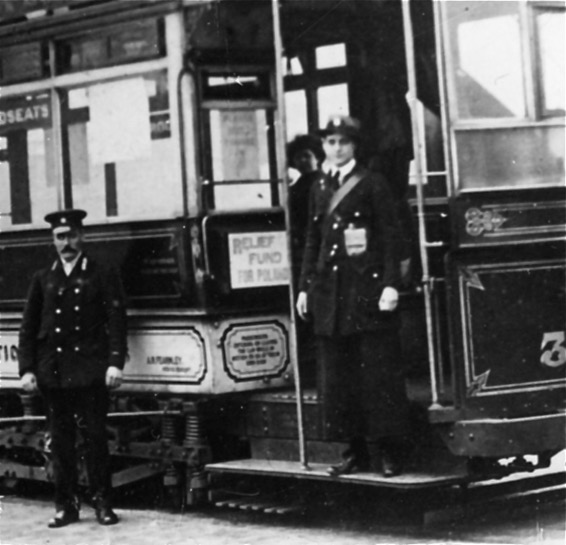
A slightly out-of-focus shot, but one which does show a Great War conductress aboard a tramcar, No 352 bound for Woodseats. Photo courtesy of the Tramways and Light Railway Society, with thanks to David Voice.
An excellent study of a Sheffield Corporation Transport tram conductress — photo undated, but probably taken during or shortly after the Second World War. The jacket appears to bear faux pocket closures, the top of the pocket being open like a slit pocket. The military-style field cap with its long peak (visor) is typical of the period. Photo courtesy of the Stephen Howarth Collection.
A conductress and a motorman pose on the platform of Tramcar No 523 in the late 1950s. Both individuals' jackets appear to be completely badgeless. Photo courtesy of the Stephen Howarth Collection.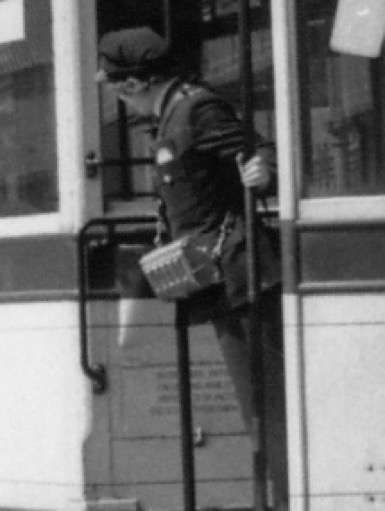
An unusual shot of a 1950s conductress leaning out from the front platform of Tramcar No 206 (bound for Handsworth), looking back down a line of waiting tramcars. She is clearly wearing trousers rather than a skirt. Photo courtesy of the Tramways and Light Railway Society, with thanks to David Voice.